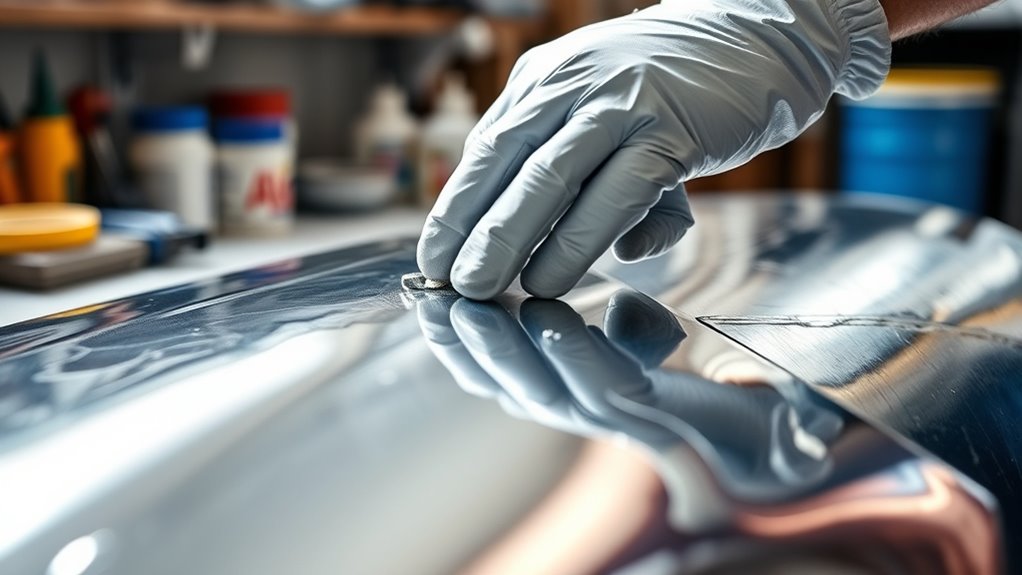To prevent corrosion on foil at home, start by regularly cleaning it with gentle, metal-safe solutions to remove dirt and grime. Dry the foil thoroughly after each cleaning and apply a light coat of protective oil or corrosion inhibitor, especially in humid or salty environments. Store the foil in a dry, low-humidity space and inspect it frequently for signs of damage or corrosion. Interested in more tips? Keep exploring to protect your foil effectively.
Key Takeaways
- Rinse foil with warm water regularly to remove dirt and debris, preventing buildup that can cause corrosion.
- Dry foil thoroughly after cleaning using a soft towel or air drying to avoid moisture-induced corrosion.
- Apply a light protective coating of oil or corrosion inhibitor to create a moisture barrier.
- Store foil in a dry, low-humidity environment to minimize exposure to moisture and corrosive elements.
- Inspect foil periodically for signs of damage or corrosion, and treat spots promptly with gentle cleaning methods.

Maintaining your foil periodically can considerably extend its lifespan and guarantee ideal performance. When it comes to foil maintenance, one of your main priorities should be foil cleaning. Regular cleaning removes dirt, grime, and any corrosive residues that can accumulate over time. You can start by rinsing your foil with warm water to loosen surface debris. For stubborn spots, gently scrub with a soft brush or cloth dipped in mild soap or a specialized cleaning solution. Avoid harsh abrasives that could scratch or damage the foil’s surface, as this might create entry points for corrosion to develop.
Regular foil cleaning with gentle methods extends lifespan and ensures optimal performance.
Once you’ve cleaned your foil thoroughly, drying it completely is essential. Moisture left on the surface promotes corrosion, especially if your foil is made of metals prone to rusting or other forms of deterioration. Use a soft towel to pat it dry or allow it to air dry in a warm, dry environment. To further prevent moisture buildup, consider applying a light coat of protective oil or corrosion inhibitor designed for metals. This layer acts as a barrier, reducing the risk of corrosion and ensuring your foil remains in top condition longer. Additionally, storing your foil in a dry, low-humidity environment can significantly reduce the chances of corrosion occurring over time.
Corrosion prevention is a vital aspect of foil maintenance. If you notice any signs of corrosion, like discoloration, pitting, or flaky deposits, address them promptly. You can gently remove corrosion spots with a fine abrasive pad or a dedicated metal cleaner, then reapply a protective coating. Keep your storage environment in mind; storing your foil in a dry, low-humidity area helps prevent moisture-related issues. If your foil is exposed to saltwater or humid conditions regularly, consider more frequent cleanings and protective treatments to mitigate corrosion risks.
In addition to cleaning and protective measures, inspecting your foil regularly for signs of wear or damage is vital. Small cracks or chips can become entry points for corrosion, so replacing or repairing damaged sections promptly will save you from more extensive issues down the line. When cleaning, avoid using overly aggressive chemicals that could weaken the material over time. Stick to gentle, metal-safe solutions and always dry your foil thoroughly afterward. Regular inspections and proper storage are key to maintaining your foil’s integrity and preventing corrosion.
Frequently Asked Questions
How Often Should I Inspect My Foil for Corrosion?
You should inspect your foil for corrosion signs at least once every three to six months. Regular inspection frequency helps you catch early signs of corrosion, such as discoloration or rust. By staying attentive to these signs, you can address issues promptly and prevent further damage. Keep a routine to make sure your foil remains in good condition, especially if it’s exposed to moisture or harsh environments.
Can Homemade Solutions Effectively Prevent Foil Corrosion?
Homemade solutions can help prevent foil corrosion, but their effectiveness varies. You should be cautious because some DIY mixes might not provide long-lasting protection or could even accelerate corrosion if they contain inappropriate ingredients. It’s best to use tried-and-true methods like applying a light coating of oil or vinegar. Regular inspections remain essential to catch early signs of foil corrosion, ensuring your efforts are truly effective.
What Environmental Factors Accelerate Foil Corrosion Indoors?
You might think foil corrosion only happens outdoors, but indoors, high humidity can accelerate it, making your foil weaken faster. Chemical exposure from cleaning agents or pollutants in the air also speeds up corrosion. To protect your foil, control humidity levels and minimize contact with harsh chemicals. Keeping your environment dry and clean creates a barrier, helping your foil last longer and stay intact.
Is It Safe to Use Abrasive Cleaners on Foil?
Using abrasive cleaners on foil isn’t safe because they can cause abrasive damage, scratching or weakening the foil’s surface. Instead, opt for cleaner alternatives like mild soap and water or vinegar solutions, which gently clean without harming the foil. You want to avoid harsh scrubbing to keep your foil in good condition, and these safer options help prevent corrosion and damage over time.
How Do Temperature Fluctuations Affect Foil Longevity?
Temperature fluctuations definitely impact foil longevity because they cause thermal expansion and contraction, which can weaken the material over time. When cold and hot conditions alternate, moisture infiltration becomes a bigger risk, leading to corrosion. You might think foil’s durable, but these repeated cycles accelerate wear. To extend its life, try to keep temperature changes steady and avoid exposing foil to extreme hot or cold environments whenever possible.
Conclusion
So, there you have it—your foolproof plan to keep that foil shiny and corrosion-free. Who knew a little DIY effort could save your kitchen from the terrifying fate of rust and decay? Now, go ahead, wield those cleaning supplies like a superhero, and prove that even foil can stay fabulous. After all, if your foil can resist corrosion, so can your sense of humor. Stay shiny, stay smart, and avoid the dreaded foil apocalypse!










